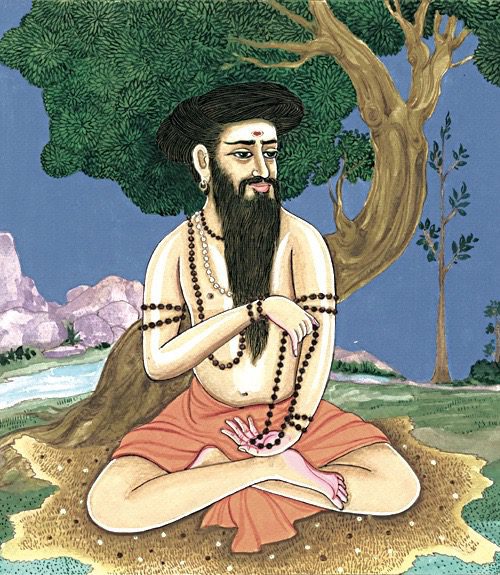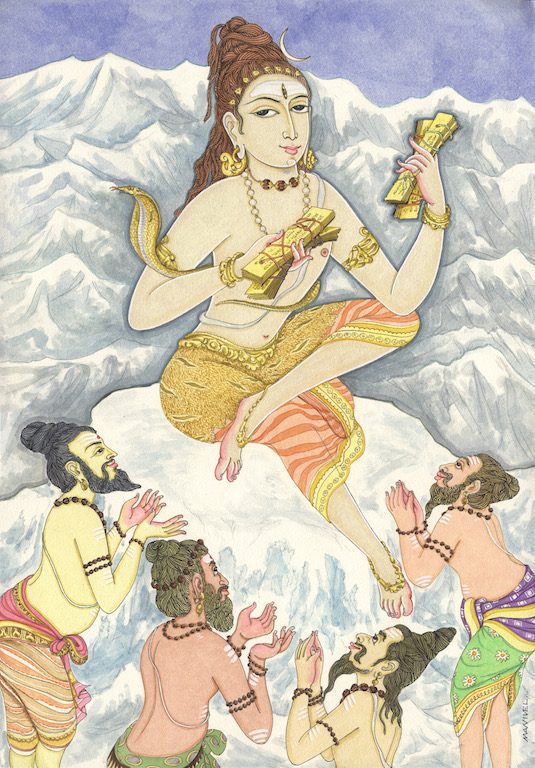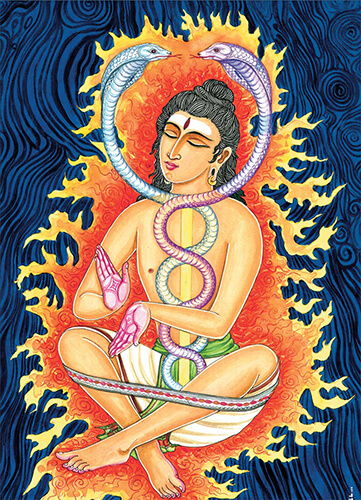So I started to read. Suddenly I came across David Frawley’s works, and from the very fist page I understood that he had the answers I’ve been looking for. Difficult topics so simply explained, with a deep understanding of ancient roots of modern practices.
By this article I aim to shed some light over the questions I had, in case someone also feels lost between them.
Lets start with reminder of what Yoga means.
«Yogas citta-vrtti-nirodhah»
This very well known phrase, which is a foundational definition of Yoga from Patanjali’s Yoga Sutras, says us, that «Yoga is the cessation (nirodhah) of the fluctuations (vrtti) of the mind (citta).»
That means turning the mind inward, taking mind’s fluctuations back to its source, to where it comes from, connecting to inner self and becoming one with eternal Being-Consciousness-Bliss.
What is Tantra? And what does it have to do with sex?
We can find lots of content on Instagram and Facebook reducing Tantra to its sexual aspects which is nothing but drop in the ocean.
«Sexual rituals does represent an aspect of Tantra, but Tantra is much more than only that. The broad approach of contains ways to turn all ordinary activities - including breath, eating, sleeping -into rituals or sacred actions, but this does not mean that Tantra is promoting such activities for ordinary gratification.» David Frawley – “Inner Tantric Yoga: Working with the Universal Shakti”
When Tantra entered the West, especially in the 20th century, some groups focused almost exclusively on sexual practices—branding it as “sacred sex” or “neo-Tantra”—detaching it from its rich spiritual roots. This selective adaptation made Tantra seem like a sex-based philosophy.
Tantra is in fact an ancient spiritual science deeply rooted in the Vedic tradition, that works with the duality of this existence, and aims to bring opposite energies and principles of our world into unity. Tantra teaches the union of Shiva (consciousness) and Shakti (energy), which some interpret literally as sexual union. While this can be symbolically or ritually enacted in advanced practices, it represents a spiritual and energetic merging, not simply physical intimacy.
We have to understand that there is an inner and outer way of doing all our «spiritual» practices. And inner path of Tantra focuses on the subtle body, chakras, mantras, and the awakening of Shakti—not on physical sexuality.
“Tantric Yoga is about the raising of energy through devotion, meditation, and subtle practices, not the external act of sex, which is but a gross symbol of inner union.” David Frawley – “Inner Tantric Yoga: Working with the Universal Shakti”
The Essence of Tantra Yoga
As a Sanskrit word Tantra means ‘book’. To be more particular - any book that contains information and techniques or philosophy as well. Basically its a book that contains knowledge on any field of human life. First time term Tantra appears around 2000 years ago and besides Hindu texts is also used Buddhism and Djainism
As a philosophy, according to David Frawley, Tantra Yoga is an energetic approach to the spiritual path, its the path of Shakti. Shakti - is the power, the force of smth in all its forms—psychological, spiritual, and cosmic.. Everything has its Shakti, that brings it to life. You may have Sun, but Shakti is what makes it shine, move and hit.
Tantra recognizes the universe as a manifestation of the Divine Feminine—Shakti—and teaches that liberation (moksha) comes through the realization and integration of this energy.
While classical yoga often emphasizes renunciation and detachment, Tantra embraces the world as a vehicle for spiritual growth. It does not reject life; instead, it seeks to spiritualize every aspect of it.
Frawley writes in “Tantric Yoga and the Wisdom Goddesses” that Tantra is a system that works with the dynamic forces of nature, the inner energies of the body and mind, and the archetypal powers of the cosmos. This makes Tantra both practical and mystical—it involves rituals, meditation, mantras, visualization, and often the worship of divine forms like the Mahavidyas (Ten Wisdom Goddesses), each representing a different aspect of the Divine, which stands for a different Force of nature.
Whats the difference between Tantra, Kundalini and Hatha Yoga and how do they relate?
Tantra Yoga, Kundalini Yoga, and Hatha Yoga are closely related but distinct paths within the broader yogic tradition. Each emphasizes different aspects of spiritual practice, although they sometimes overlap.
In short:
- Tantra is the philosophical umbrella that often includes the other two.
- Kundalini Yoga is the energetic activation path rooted in Tantra.
- Hatha Yoga is the preparatory and physical discipline that supports both.
Here’s a breakdown of their key differences:
⸻
Tantra Yoga
Focus: Spiritualizing all aspects of life through energy work and sacred ritual
Key Concepts: Shakti, Mantra, Yantra, Ritual, Non-duality
- Tantra Yoga is the broadest and most philosophical of the three.
- It integrates rituals, mantra, meditation, deity worship, and energy awakening techniques to transform the practitioner spiritually.
- It aims to awaken Shakti (Divine Feminine energy) and unite it with Shiva (pure consciousness).
- Tantra includes elements of kundalini and hatha, but it frames them within a larger cosmological and symbolic system.
- As David Frawley explains, Tantra is about using all aspects of life—including the body, senses, and emotions—as tools for spiritual liberation.
⸻
Kundalini Yoga
Focus: Awakening dormant energy (kundalini) and guiding it through the chakras
Rooted in: Tantra Yoga
Key Concepts: Chakras, Nadis, Prana, Shakti, Breathwork
- Kundalini Yoga is often seen as a subset of Tantra focused specifically on awakening the kundalini energy at the base of the spine.
- It uses Kriyas - a complex of techniques as: breathwork (pranayama), mantra, meditation, bandhas (energy locks), and dynamic movements to guide kundalini through the chakras.
- The style popularized by Yogi Bhajan is distinct and includes modern innovations, while older, classical Kundalini Yoga has deep tantric roots.
- The ultimate goal is to reach spiritual awakening by merging kundalini (Shakti) with the higher consciousness (Shiva).
⸻
Hatha Yoga
Focus: Physical purification and energy control through posture and breath
Rooted in: Tantra Yoga
Key Concepts: Asana, Pranayama, Mudras, Bandhas, Discipline, Shatkaramas
- Hatha Yoga focuses on asana (postures) and pranayama to prepare the body and mind for deeper meditation and Kundalini awakening.
- The word “Hatha” comes from Sanskrit: “Ha” meaning sun and “Tha” meaning moon—symbolizing the union of opposites, such as strength and flexibility, effort and surrender, masculine and feminine, or the solar and lunar energies within usIt aims to balance the solar (ha) and lunar (tha) energies in the body.
- While modern Hatha often seems fitness-based, its original purpose was energetic purification and preparation for kundalini awakening.
- Hatha Yoga is non-sectarian and doesn’t always include the ritualistic or philosophical elements of Tantra.
The Essence of Hatha Yoga
As it already was said the word “Hatha” comes from Sanskrit: “Ha” meaning sun and “Tha” meaning moon—symbolizing the union of opposites, such as strength and flexibility, effort and surrender, masculine and feminine, or the solar and lunar energies within us. It aims to balance the solar (ha) and lunar (tha) energies in the body. Those are tantric roots.
Hatha Yoga is not just about the body; it is a complete system of energetic purification and transformation. Its techniques include asana, pranayama (control of life force through breath), mudra (gestures to direct energy), bandha (energy locks), and shatkarma (cleansing practices). These tools are not for fitness, but for preparing the body and mind to enter deep states of meditation and ultimately, spiritual awakening.
Swami Satyananda Saraswati emphasized that Hatha Yoga is about means to awaken consciousness, not an end in itself. "By purifying the nadis (energy channels) and balancing the prana (life force), the practitioner becomes ready for the awakening of kundalini—the latent spiritual energy at the base of the spine."
In this sense, Hatha Yoga serves as the foundation for higher yogic practices such as Raja Yoga, Kundalini Yoga, and Tantra. But when practiced with awareness, it aligns body, breath, and mind, making it a potent gateway to self-realization, which in the present of Grace doesn’t need any other tools.
If you see a bowl only as a hat, it won’t serve its real purpose of holding food. Similarly, if you treat a yoga pose only as physical exercise, you’ll miss out on the deeper purpose of Yoga.
Yoga doesn’t work automatically—you must bring conscious intention to each posture. When you approach a pose with the aim of cultivating discipline, sharpening focus, spreading awareness through your body, or connecting with more subtle levels of consciousness, you open the door to those experiences.
But if you enter a pose simply expecting it to stretch your hip flexors and then dismiss Hatha Yoga as just a workout, you’ve already limited what it can offer. The boundaries you perceive are the ones you’ve chosen to place.
The Essence of Kundalini Yoga
Kundalini Yoga was introduced to the West by Yogi Bhadjan in 1969 and has gained widespread popularity—for several compelling reasons. Its appeal lies in its powerful, immediate effects, its mystical promise, and its structured practices that feel both ancient and accessible.
«Kundalini literally means a coiled-up energy or the power that dwells in a cave( kunda). For any transformation to be possible an anergy is needed to bring it about. For the transformation of consciousness a special and powerful energy is needed. This is Kundalini….
Kundalini is a form of the Goddess and should be worshiped as Her power. It is not a physical energy to be aroused but a Divine energy to be revered.»
Taking it beyond the mystic, Kundalini is the same Prana or life energy that permeates everything around and in us with two particularities it is a huge and strong amount energy, and It is dormant.
The main instrument for this type of yoga is Kriya.
A kriya is a specific sequence of exercises, postures (asanas), breath control (pranayama), hand positions (mudras), and sounds (mantras) that work synergistically to achieve a particular outcome—be it physical, emotional, or spiritual.
“Kriya is not just exercise. Kriya is a tool to awaken your awareness.” – Yogi Bhajan
What is important to notice is that arouse of Kundalini should not be approached as an end in itself, but as a step towards to a new consciousness, which can evaluate only in the presence of Grace, when the time comes.
In «Tantric Yoga and the Wisdom Goddess» David Frawley writes :
«Many yogis, including Tantrics, may use no specific practices or Pranic manipulations to arouse Kundalini. The arousing o Kundalini can occur through intense devotion or profound meditation and does not require the use of specific Yoga techniques.. When Yoga techniques are used to arouse the Kundalini - and are often very helpful - they should be done as part of a practice o surrender to the Divine or inquiry into Self- nature»
As Yogi Bhadjan said « Kundalini Yoga is the science to unite the finite with Infinity, and it’s the art to experience Infinity in the finite» and my favorite «If you can’t see God in all, you can’t see God at all».
What Are “Kundalini Awakening Sessions”?
«Efforts to manipulate Kundalini through willful practice or forceful techniques are not only dangerous, but fail to recognize the reality of the Goddess and are contrary to her worship»- Tantric Yoga and the Wisdom Goddess. David Frawley
Those sessions refer to guided experiences or therapies designed to stimulate or awaken the dormant kundalini energy at the base of the spine. They’re not always rooted in classical yoga traditions—and their quality varies widely.
We can distinguish two main types:
1. Classical Kundalini Awakening (Traditional Yogic/Tantric)
- Involves long-term, disciplined sadhana (spiritual practice).
- Uses asana, pranayama, mantra, bandhas, and meditation to gradually awaken and guide kundalini up the chakras.
- Safely supported by a trained guru or lineage holder.
- Found in systems like Bihar School of Yoga, Sri Vidya Tantra, or the teachings of Yogi Bhadjan and David Frawley.
2. Modern “Kundalini Activation” Sessions
Often offered as:
- KAP (Kundalini Activation Process)
- Shaktipat sessions (energy transmissions)
- Energy healing + breathwork hybrids
These sessions usually:
- Involve lying down, with a facilitator guiding energy through music, touch, or non-verbal transmission.
- Claim to “activate” dormant energy without prior training.
- May cause intense emotional release, body movement, or visions.
- No Parampara( linage ), no school, no actual Guru.
Caution:️ These are not always grounded in yogic tradition and can be destabilizing without preparation. Spontaneous awakenings can cause kundalini syndrome—symptoms like anxiety, insomnia, and emotional overload if not well integrated.
In conclusion I’d like say that any type of Yoga is a sacred pathways that guide us home — to the Divine within and the unity that connects all beings. As we move, breathe, and chant, we dissolve the illusion of separation. What remains is pure presence, a remembering of our true nature: infinite, radiant, and deeply connected to the soul of the universe.








